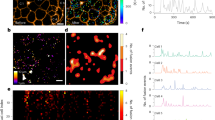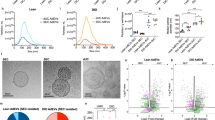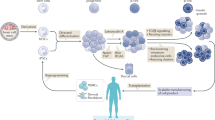Abstract
Generating artificial pancreatic beta cells by using synthetic materials to mimic glucose-responsive insulin secretion in a robust manner holds promise for improving clinical outcomes in people with diabetes. Here, we describe the construction of artificial beta cells (AβCs) with a multicompartmental 'vesicles-in-vesicle' superstructure equipped with a glucose-metabolism system and membrane-fusion machinery. Through a sequential cascade of glucose uptake, enzymatic oxidation and proton efflux, the AβCs can effectively distinguish between high and normal glucose levels. Under hyperglycemic conditions, high glucose uptake and oxidation generate a low pH (<5.6), which then induces steric deshielding of peptides tethered to the insulin-loaded inner small liposomal vesicles. The peptides on the small vesicles then form coiled coils with the complementary peptides anchored on the inner surfaces of large vesicles, thus bringing the membranes of the inner and outer vesicles together and triggering their fusion and insulin 'exocytosis'.
This is a preview of subscription content, access via your institution
Access options
Access Nature and 54 other Nature Portfolio journals
Get Nature+, our best-value online-access subscription
$29.99 / 30 days
cancel any time
Subscribe to this journal
Receive 12 print issues and online access
$259.00 per year
only $21.58 per issue
Buy this article
- Purchase on Springer Link
- Instant access to full article PDF
Prices may be subject to local taxes which are calculated during checkout




Similar content being viewed by others
Accession codes
Change history
14 November 2017
In the version of this article initially published online, the wavelength depicted at the top of Figure 2g was mislabeled as 563 nm instead of 536 nm. The error has been corrected in the PDF and HTML versions of this article.
References
Rorsman, P. & Braun, M. Regulation of insulin secretion in human pancreatic islets. Annu. Rev. Physiol. 75, 155–179 (2013).
Yu, J. et al. Microneedle-array patches loaded with hypoxia-sensitive vesicles provide fast glucose-responsive insulin delivery. Proc. Natl. Acad. Sci. USA 112, 8260–8265 (2015).
Ohkubo, Y. et al. Intensive insulin therapy prevents the progression of diabetic microvascular complications in Japanese patients with non-insulin-dependent diabetes mellitus: a randomized prospective 6-year study. Diabetes Res. Clin. Pract. 28, 103–117 (1995).
Nathan, D.M. Long-term complications of diabetes mellitus. N. Engl. J. Med. 328, 1676–1685 (1993).
Nathan, D.M. The diabetes control and complications trial/epidemiology of diabetes interventions and complications study at 30 years: overview. Diabetes Care 37, 9–16 (2014).
Nathan, D.M. et al. The effect of intensive treatment of diabetes on the development and progression of long-term complications in insulin-dependent diabetes mellitus. N. Engl. J. Med. 329, 977–986 (1993).
Orchard, T.J. et al. Association between 7 years of intensive treatment of type 1 diabetes and long-term mortality. J. Am. Med. Assoc. 313, 45–53 (2015).
Xie, M. et al. β-cell-mimetic designer cells provide closed-loop glycemic control. Science 354, 1296–1301 (2016).
Pepper, A.R. et al. A prevascularized subcutaneous device-less site for islet and cellular transplantation. Nat. Biotechnol. 33, 518–523 (2015).
Vegas, A.J. et al. Long-term glycemic control using polymer-encapsulated human stem cell-derived beta cells in immune-competent mice. Nat. Med. 22, 306–311 (2016).
Veiseh, O., Tang, B.C., Whitehead, K.A., Anderson, D.G. & Langer, R. Managing diabetes with nanomedicine: challenges and opportunities. Nat. Rev. Drug Discov. 14, 45–57 (2015).
Zhang, Y., Ruder, W.C. & LeDuc, P.R. Artificial cells: building bioinspired systems using small-scale biology. Trends Biotechnol. 26, 14–20 (2008).
Szostak, J.W., Bartel, D.P. & Luisi, P.L. Synthesizing life. Nature 409, 387–390 (2001).
Hu, C.-M.J., Fang, R.H., Luk, B.T. & Zhang, L. Nanoparticle-detained toxins for safe and effective vaccination. Nat. Nanotechnol. 8, 933–938 (2013).
Hu, C.-M.J. et al. Nanoparticle biointerfacing by platelet membrane cloaking. Nature 526, 118–121 (2015).
Brown, A.C. et al. Ultrasoft microgels displaying emergent platelet-like behaviours. Nat. Mater. 13, 1108–1114 (2014).
Hu, Q. et al. Engineered nanoplatelets for enhanced treatment of multiple myeloma and thrombus. Adv. Mater. 28, 9573–9580 (2016).
Molinaro, R. et al. Biomimetic proteolipid vesicles for targeting inflamed tissues. Nat. Mater. 15, 1037–1046 (2016).
Boyer, C. & Zasadzinski, J.A. Multiple lipid compartments slow vesicle contents release in lipases and serum. ACS Nano 1, 176–182 (2007).
Wong, B. et al. Design and in situ characterization of lipid containers with enhanced drug retention. Adv. Mater. 23, 2320–2325 (2011).
Marguet, M., Edembe, L. & Lecommandoux, S. Polymersomes in polymersomes: multiple loading and permeability control. Angew. Chem. Int. Ed. Engl. 51, 1173–1176 (2012).
Peters, R.J.R.W. et al. Cascade reactions in multicompartmentalized polymersomes. Angew. Chem. Int. Ed. Engl. 53, 146–150 (2014).
Elani, Y., Law, R.V. & Ces, O. Vesicle-based artificial cells as chemical microreactors with spatially segregated reaction pathways. Nat. Commun. 5, 5305–5309 (2014).
Chiu, H.-C., Lin, Y.-W., Huang, Y.-F., Chuang, C.-K. & Chern, C.-S. Polymer vesicles containing small vesicles within interior aqueous compartments and pH-responsive transmembrane channels. Angew. Chem. Int. Ed. Engl. 47, 1875–1878 (2008).
Lu, Y., Aimetti, A.A., Langer, R. & Gu, Z. Bioresponsive materials. Nat. Rev. Mater. 2, 16075 (2016).
Hata, Y., Slaughter, C.A. & Südhof, T.C. Synaptic vesicle fusion complex contains unc-18 homologue bound to syntaxin. Nature 366, 347–351 (1993).
Kaiser, C.A. & Schekman, R. Distinct sets of SEC genes govern transport vesicle formation and fusion early in the secretory pathway. Cell 61, 723–733 (1990).
Söllner, T. et al. SNAP receptors implicated in vesicle targeting and fusion. Nature 362, 318–324 (1993).
Marsden, H.R., Tomatsu, I. & Kros, A. Model systems for membrane fusion. Chem. Soc. Rev. 40, 1572–1585 (2011).
Lygina, A.S., Meyenberg, K., Jahn, R. & Diederichsen, U. Transmembrane domain peptide/peptide nucleic acid hybrid as a model of a SNARE protein in vesicle fusion. Angew. Chem. Int. Ed. Engl. 50, 8597–8601 (2011).
Robson Marsden, H., Elbers, N.A., Bomans, P.H.H., Sommerdijk, N.A.J.M. & Kros, A. A reduced SNARE model for membrane fusion. Angew. Chem. Int. Ed. Engl. 48, 2330–2333 (2009).
Meyenberg, K., Lygina, A.S., van den Bogaart, G., Jahn, R. & Diederichsen, U. SNARE derived peptide mimic inducing membrane fusion. Chem. Commun. (Camb.) 47, 9405–9407 (2011).
Tomatsu, I. et al. Influence of pegylation on peptide-mediated liposome fusion. J. Mater. Chem. 21, 18927–18933 (2011).
Kong, L., Askes, S.H.C., Bonnet, S., Kros, A. & Campbell, F. Temporal control of membrane fusion through photolabile PEGylation of liposome membranes. Angew. Chem. Int. Ed. Engl. 55, 1396–1400 (2016).
Gong, Y., Ma, M., Luo, Y. & Bong, D. Functional determinants of a synthetic vesicle fusion system. J. Am. Chem. Soc. 130, 6196–6205 (2008).
Chan, Y.-H.M., van Lengerich, B. & Boxer, S.G. Effects of linker sequences on vesicle fusion mediated by lipid-anchored DNA oligonucleotides. Proc. Natl. Acad. Sci. USA 106, 979–984 (2009).
Steinmetz, M.O. et al. Molecular basis of coiled-coil formation. Proc. Natl. Acad. Sci. USA 104, 7062–7067 (2007).
Mo, R., Jiang, T. & Gu, Z. Enhanced anticancer efficacy by ATP-mediated liposomal drug delivery. Angew. Chem. Int. Ed. Engl. 53, 5815–5820 (2014).
Zhao, C., Qu, K., Ren, J. & Qu, X. Proton-fueled DNA-duplex-based stimuli-responsive reversible assembly of single-walled carbon nanotubes. Chemistry 17, 7013–7019 (2011).
Li, X., Peng, Y., Ren, J. & Qu, X. Carboxyl-modified single-walled carbon nanotubes selectively induce human telomeric i-motif formation. Proc. Natl. Acad. Sci. USA 103, 19658–19663 (2006).
Kisak, E.T., Coldren, B. & Zasadzinski, J.A. Nanocompartments enclosing vesicles, colloids, and macromolecules via interdigitated lipid bilayers. Langmuir 18, 284–288 (2002).
Tunuguntla, R.H., Allen, F.I., Kim, K., Belliveau, A. & Noy, A. Ultrafast proton transport in sub-1-nm diameter carbon nanotube porins. Nat. Nanotechnol. 11, 639–644 (2016).
Efrat, S. Making sense of glucose sensing. Nat. Genet. 17, 249–250 (1997).
Matsumoto, R. et al. A liposome-based energy conversion system for accelerating the multi-enzyme reactions. Phys. Chem. Chem. Phys. 12, 13904–13906 (2010).
Wang, Z. & Thurmond, D.C. Mechanisms of biphasic insulin-granule exocytosis: roles of the cytoskeleton, small GTPases and SNARE proteins. J. Cell Sci. 122, 893–903 (2009).
Schuette, C.G. et al. Determinants of liposome fusion mediated by synaptic SNARE proteins. Proc. Natl. Acad. Sci. USA 101, 2858–2863 (2004).
Mo, R., Jiang, T., Di, J., Tai, W. & Gu, Z. Emerging micro- and nanotechnology based synthetic approaches for insulin delivery. Chem. Soc. Rev. 43, 3595–3629 (2014).
Kitabchi, A.E., Umpierrez, G.E., Miles, J.M. & Fisher, J.N. Hyperglycemic crises in adult patients with diabetes. Diabetes Care 32, 1335–1343 (2009).
Park, M.H., Joo, M.K., Choi, B.G. & Jeong, B. Biodegradable thermogels. Acc. Chem. Res. 45, 424–433 (2012).
Ye, H., Daoud-El Baba, M., Peng, R.-W. & Fussenegger, M. A synthetic optogenetic transcription device enhances blood-glucose homeostasis in mice. Science 332, 1565–1568 (2011).
Peppas, N.A. & Khademhosseini, A. Make better, safer biomaterials. Nature 540, 335–338 (2016).
Bakh, N.A. et al. Glucose-responsive insulin by molecular and physical design. Nat. Chem. 9, 937–943 (2017).
Boni, L.T. et al. Curvature dependent induction of the interdigitated gel phase in DPPC vesicles. Biochim. Biophys. Acta 1146, 247–257 (1993).
Ahl, P.L. et al. Interdigitation-fusion: a new method for producing lipid vesicles of high internal volume. Biochim. Biophys. Acta 1195, 237–244 (1994).
Kasahara, M. & Hinkle, P.C. Reconstitution of D-glucose transport catalyzed by a protein fraction from human erythrocytes in sonicated liposomes. Proc. Natl. Acad. Sci. USA 73, 396–400 (1976).
Kano, K. & Fendler, J.H. Pyranine as a sensitive pH probe for liposome interiors and surfaces. pH gradients across phospholipid vesicles. Biochim. Biophys. Acta 509, 289–299 (1978).
Acknowledgements
This work was supported by grants from the American Diabetes Association (grant no. 1-15-ACE-21 to Z.G.), Alfred P. Sloan Foundation (Sloan Research Fellowship to Z.G.), National Science Foundation (grant no. 1708620 to Z.G.) and NC TraCS, NIH's Clinical and Translational Science Award (CTSA, grant no. 1UL1TR001111) at UNC-CH. This work was performed in part at the Analytical Instrumentation Facility (AIF) at North Carolina State University, which is supported by the State of North Carolina and the National Science Foundation (grant no. 1542015). The AIF is a member of the North Carolina Research Triangle Nanotechnology Network (RTNN), a site in the National Nanotechnology Coordinated Infrastructure (NNCI). The authors also thank P. Chipman and R. Alvarado at the University of Florida's ICBR center.
Author information
Authors and Affiliations
Contributions
Z.C., F.S.L., J.B.B. and Z.G. designed the project; Z.C., J.W., W.S., E.A., X.Z. and Y.L. performed the experiments; Z.C., J.W., W.S., X.Z., E.A., Y.L. and Z.G. analyzed the data; Z.C., J.W., A.R.K., J.B.B., F.S.L. and Z.G. wrote the paper.
Corresponding author
Ethics declarations
Competing interests
The authors declare no competing financial interests.
Supplementary information
Supplementary Text and Figures
Supplementary Results, Supplementary Table 1 and Supplementary Figures 1–34, Supplementary Note: Plasmid map and full plasmid sequence for glucose transporter 2 (GLUT2) (PDF 7430 kb)
A movie showing the liposomes-in-liposome superstructures.
The inner small liposomes were incorporated with lipids labelled with nitrobenzofuran and outer larger liposome was incorporated with lipids labeled with lissamine rhodamine B. It can be seen that the small particles were moving randomly by Brownian motion inside the large liposomes. (MOV 200 kb)
Rights and permissions
About this article
Cite this article
Chen, Z., Wang, J., Sun, W. et al. Synthetic beta cells for fusion-mediated dynamic insulin secretion. Nat Chem Biol 14, 86–93 (2018). https://doi.org/10.1038/nchembio.2511
Received:
Accepted:
Published:
Issue Date:
DOI: https://doi.org/10.1038/nchembio.2511
This article is cited by
-
Artificial cells for in vivo biomedical applications through red blood cell biomimicry
Nature Communications (2024)
-
Week-long normoglycaemia in diabetic mice and minipigs via a subcutaneous dose of a glucose-responsive insulin complex
Nature Biomedical Engineering (2023)
-
Cascade reaction networks within audible sound induced transient domains in a solution
Nature Communications (2022)
-
Synthetic cells with self-activating optogenetic proteins communicate with natural cells
Nature Communications (2022)
-
Bottom-up assembly of viral replication cycles
Nature Communications (2022)



